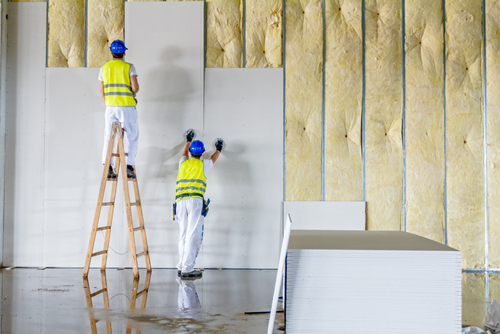First question – what exactly is gyprock?
Let’s start this article by looking at the composition of gyprock and, by association, plasterboard and drywall, all of which have basically the same composition and serve similar functions in the construction and building industries. Drywall or gyprock is composed of thin panels of gypsum board, which are relatively light-weight, strong and durable. When these panels are coated with a thin plaster veneer, they are known as plasterboard.

What is gypsum and how is it formed?
Gyprock is manufactured from a naturally-occurring soft rock-like mineral called gypsum, which is composed of calcium sulphate dihydrate. In its purest form, this mineral is white in colour, but impurities may make it appears grey, pink, yellow, brown or even black. This mineral has been formed over many millions of years as a result of the evaporation of seawater, when crystals formed in the mineral-rich sea brine and sank to the ocean floor, where they formed sedimentary rock beds through natural cementation. The evaporation phase itself lasted for thousands of years, and gypsum seams were formed and steadily buried over successive aeons. Gypsum was brought closer to the surface of the earth during the last Ice Age as a result of erosion from glaciers and melt-water, and is widely obtained through mining operations. Gypsum is mainly used in many forms of plaster (including plaster of paris), drywall and blackboard/sidewalk chalk. Gypsum is, in itself, not flammable, and the addition of water further adds to its fire-retardant attributes. Gypsum contains a relatively high volume of water bound within its crystalline composition. One square metre of gypsum board contains over two litres of water, which is particularly useful when it comes to its fire-retardation properties. Even if exposed to fire and the moisture in the boards has evaporated, it is worth remembering that gypsum itself is not flammable. An interesting fact is that ancient Assyrians gave it the name of Alabaster, and used it to create sculptures, some of which are still in existence today.
Interesting facts about gypsum
Since gypsum is not poisonous, pulverised or powdered gypsum is used in a variety of applications, including its use as a filler in some paints, cosmetics and drugs. It is also used as a soil conditioner and fertilizer on farms. Since it is an excellent source of calcium, it can be used to strengthen certain foods such as breads, and is even used in some brands of toothpaste.
Gypsum in medical usage
Bassanite, derived from gypsum which is heated to 150 deg C to remove all water molecules, is the main ingredient of plaster of paris, which is commonly used in the medical field for creating casts. It is reduced to a fine powdered form, and moistened to form a paste which is easily mouldable when wet, but when dry it retains the shape required and its rock-like attributes. It is extremely strong and yet lightweight, which makes it an ideal agent where strength without weight is a necessity. Approximately 100 billion kilograms of plaster of paris is manufactured globally on an annual basis. Bassanite itself is not found anywhere on earth due to the presence of moisture and has to be specifically manufactured from gypsum through a rigorous heating and dehydration process, but it is apparently abundant on Mars!
The making of drywall and gyprock
Gyprock is also known as gypsum board, drywall, or plasterboard. In 1894 a process of setting a layer of gypsum plaster between sheets of felt paper was invented, resulting in boards which were smooth, ready for painting and much easier and faster to erect. The term drywall came into being since the plaster was already dry, so there was no further drying time. Drywall is made primarily of raw gypsum mixed with additives such as starch, paper pulp and a thickening agent. Water is added to make a thick paste which is then sandwiched between two very thick sheets of specialized paper, one being a smooth front-facing side and the other a rougher back-facing side. The resulting product is thin panels of board which are used in the construction of internal walls and ceilings, which may be permanent or semi-permanent, unlike solid brick walls. Since they are thin and therefore flexible, these boards can be used in the creation of interior design features such as eaves, arches and specialised architectural characteristics. The boards can also be shaped to fit any area, which makes them particularly useful. Gypsum boards may be coated with a thin plaster veneer after installation, known as plasterboard. An added advantage of drywall or gyprock over plasterboard is its resistance to cracking, whereas a nail pushed into plasterboard will possibly result in a splinter at the point of impact.
Gyprock vs Plasterboard
Drywall or gyprock has better insulating properties than plasterboard, but is not as sound-proof, so these factors need to be weighed against each other when deciding which type of board to use. Plasterboard has a more high-end look, but is more labour-intensive and costly. Both plasterboard and gyprock can be painted but gyprock should be sealed prior to painting. Gypsum drywalls are, however, susceptible to moisture and will suffer water damage or mould problems if exposed to high levels of moisture over extended periods of time. This can be remedied by choosing drywall which has been specially treated against the ingress of moisture, which is especially useful in bathrooms. Both plasterboard and Gyprock walls will support pictures of varying sizes and weights, but you need to be careful about the hooks or nails you are using for this purpose.
Who installs and works with Gyprock?
There are specialists who work specifically with gyprock and plasterboard, and are able to advise on the best choices for your needs. For further information about these specialists, have a look through Uptasker’s listings in this area.